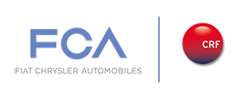Address:
Centro Ricerche FIAT S.C.p.A.
Strada Torino, 50
10043 Orbassano (TO), Italia

About CRF
CRF (Centro Ricerche Fiat), headquartered in Orbassano (Turin) with other branch sites in Italy, was established in 1978.). As a focal point for research activities of FCA (Fiat Chrysler Automobiles), focuses on research and innovation along environmental and social sustainability and also economically sustainable competitiveness. CRF has the mission to:
- develop and transfer innovative powertrains, vehicle systems and features, materials, processes and methodologies together with innovation expertise in order to improve the competitiveness of FCA products;
- represent FCA in European collaborative research programs, joining pre-competitive projects and promoting networking actions;
- support FCA in the protection and enhancement of intellectual property.
Also, through the cooperation with a pan-European and increasingly global network from industry and academia, CRF conducts collaborative research initiatives at the national and international levels in partnership with all the key public and private stakeholders concerned with sustainable mobility, targeting specifically the industrial exploitation of research.
Main role in the project
CRF is contributing to the:
- Contribution to general terminology identification, understanding of existing testing and validation procedures in the automotive sector, identification of Key Enabling Technologies (KETs) requirements, use cases identification from an Original Equipment Manufacturers (OEM) perspective;
- Identification of specific tools to be used for KETs testing and validation. Selection of criteria which can be used to select scenarios which are relevant for the validation of specific automated driving functions;
- Identification of assessment criteria and KPIs to assess (Connected Automated Driving) CAD functionalities from an OEM point of view with particular emphasis on positioning and V2X communication. Design of testing and validation procedures for CAD functions based on the OEM experiences and existing methodologies;
- Testing activities, data collection and analysis, demonstration activities;
- Dissemination of results to conferences and events.
